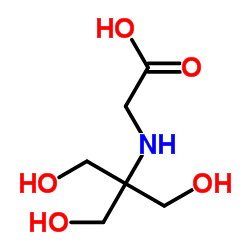Tricine

Tricine structure
|
Common Name | Tricine | ||
|---|---|---|---|---|
| CAS Number | 5704-04-1 | Molecular Weight | 179.171 | |
| Density | 1.5±0.1 g/cm3 | Boiling Point | 500.9±50.0 °C at 760 mmHg | |
| Molecular Formula | C6H13NO5 | Melting Point | 186-188 °C (dec.) | |
| MSDS | Chinese USA | Flash Point | 256.7±30.1 °C | |
|
Anaphylaxis induced by a drug containing lysozyme and papain: influence of papain on the IgE response.
Int. Arch. Allergy Immunol. 165(2) , 83-90, (2014) This paper reports the case of an egg-allergic pediatric patient who, once desensitized to egg following a successful rush oral immunotherapy protocol, could also tolerate Lizipaina®, a drug containing lysozyme (LYS) and papain, which had previously caused hi... |
|
|
Aeromonas piscicola AH-3 expresses an extracellular collagenase with cytotoxic properties.
Lett. Appl. Microbiol. 60(3) , 288-97, (2015) The aim of this study was to investigate the presence and the phenotypic expression of a gene coding for a putative collagenase. This gene (AHA_0517) was identified in Aeromonas hydrophila ATCC 7966 genome and named colAh. We constructed and characterized an ... |
|
|
Solubilization of gliadins for use as a source of nitrogen in the selection of bacteria with gliadinase activity.
Food Chem. 168 , 439-44, (2014) For patients with celiac disease, gliadin detoxification via the use of gliadinases may provide an alternative to a gluten-free diet. A culture medium, in which gliadins were the sole source of nitrogen, was developed for screening for microorganisms with gli... |
|
|
A novel strategy for the discrimination of gelatinous Chinese medicines based on enzymatic digestion followed by nano-flow liquid chromatography in tandem with orbitrap mass spectrum detection.
Int. J. Nanomedicine 10 , 4947-55, (2015) Gelatinous Chinese medicines made from mammalian skin or horn or reptile shell are a very important type of animal-derived Chinese medicine. They have been extensively used either as both hemopoietic and hemostatic agents to treat vertigo, palpitation, hematu... |
|
|
PeBL1, a novel protein elicitor from Brevibacillus laterosporus strain A60, activates defense responses and systemic resistance in Nicotiana benthamiana.
Appl. Environ. Microbiol. 81(8) , 2706-16, (2015) We report the identification, characterization, and gene cloning of a novel protein elicitor (PeBL1) secreted from Brevibacillus laterosporus strain A60. Through a purification process consisting of ion-exchange chromatography and high-performance liquid chro... |
|
|
A synchrotron-based hydroxyl radical footprinting analysis of amyloid fibrils and prefibrillar intermediates with residue-specific resolution.
Biochemistry 53(49) , 7724-34, (2014) Structural models of the fibrils formed by the 40-residue amyloid-β (Aβ40) peptide in Alzheimer's disease typically consist of linear polypeptide segments, oriented approximately perpendicular to the long axis of the fibril, and joined together as parallel in... |
|
|
Liquid chromatography-mass spectrometry based serum peptidomic approach for renal clear cell carcinoma diagnosis.
J. Pharm. Biomed. Anal. 100 , 175-83, (2014) Serum peptidomic approach was applied to investigate the peptidomic signature and discover the clinical biomarkers and biomarker patterns for RCC patients. The holistic orthogonal partial least-squares-discriminant analysis (OPLS-DA) based on qualified profil... |
|
|
The Escherichia coli small protein MntS and exporter MntP optimize the intracellular concentration of manganese.
PLoS Genet. 11(3) , e1004977, (2015) Escherichia coli does not routinely import manganese, but it will do so when iron is unavailable, so that manganese can substitute for iron as an enzyme cofactor. When intracellular manganese levels are low, the cell induces the MntH manganese importer plus M... |
|
|
Protease-degradable electrospun fibrous hydrogels.
Nat. Commun. 6 , 6639, (2015) Electrospun nanofibres are promising in biomedical applications to replicate features of the natural extracellular matrix (ECM). However, nearly all electrospun scaffolds are either non-degradable or degrade hydrolytically, whereas natural ECM degrades proteo... |
|
|
Multifaceted genome control by Set1 Dependent and Independent of H3K4 methylation and the Set1C/COMPASS complex.
PLoS Genet. 10(10) , e1004740, (2014) Histone modifiers are critical regulators of chromatin-based processes in eukaryotes. The histone methyltransferase Set1, a component of the Set1C/COMPASS complex, catalyzes the methylation at lysine 4 of histone H3 (H3K4me), a hallmark of euchromatin. Here, ... |